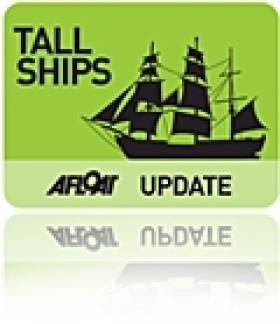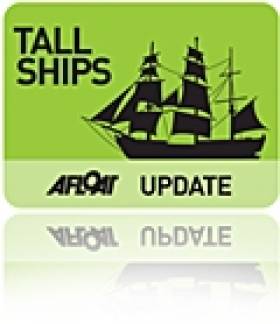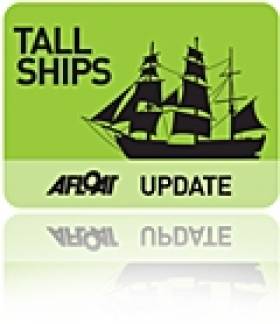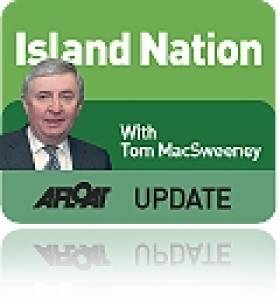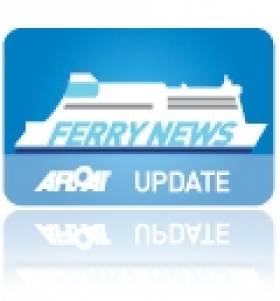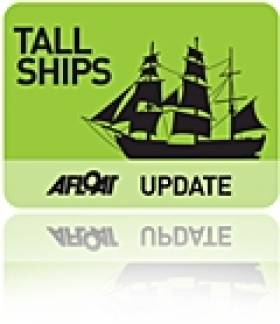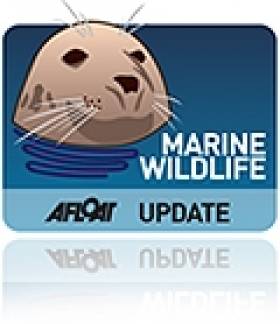Displaying items by tag: Waterford
Hamburg Gets Ready to Host World's Biggest Ports Festival
Billed as the world's greatest Port Festival, five of the world's largest and most beautiful tall ships – and at least one, the Mir, is also entered for the Tall Ships race in Waterford in June – have announced their presence at Hamburg next month.
Also coming to Hamburg is the Dar Mlodziezy, the Kruzenshtern, the Mir, the Sedov and the Sea Cloud. Each of these classic sailing ships, at home on the oceans of the world, is more than 100 metres in length, and captures the romance of maritime life.
The HAFENGEBURTSTAG HAMBURG has a thing or two to show off about given its large fleet of boats and Tall Ships that are gathering this year for the 822nd time. It's an opportunity to for Irish port festivals aiming to exploit the marine leisure resources around the Irish coastline.
The Sea Cloud, built in Kiel in 1931, and the largest private yacht in the world at the time, will be present at HAFENGEBURTSTAG HAMBURG for the first time, back in Hamburg for the first time in 33 years.
In Hamburg, there will be tall ships and cruise vessels, naval ships and emergency service boats, heritage and museum ships, sailing and motor yachts, dragon boats, and even a Roman galley. Altogether more than 300 vessels from the seven seas will be taking part, on display in their element before the fantastic backdrop of Hamburg's Landing Stages (Landungsbrücken) from 6 to 8 May at the world's greatest Port Festival.
The port is more lively than ever on the three days of HAFENGEBURTSTAG HAMBURG", says Captain Jörg Pollmann, in eager anticipation. "All those different ships and displays on the Elbe combine to form a unique celebration, which brings more than a million visitors to the Port of Hamburg every year." The guests from Germany and abroad can look forward to a superlative programme on the water, starting with the Grand Arrival Parade from 16:30 on Friday 6 May, and ending with the Grand Departure Parade at 17:30 on Sunday 8 May. There are also plenty of maritime attractions at the Oevelgönne Heritage Harbour and at the HafenCity traditional maritime harbour.
Meeting of the luxury liners
Visitors are warned that watching the six cruise ships arriving and departing on the three days of HAFENGEBURTSTAG HAMBURG may cause itchy feet and severe travelitis! The AIDAcara, AIDAblu and Mein Schiff 2 will be arriving on the Friday, the Amadea and the Fram, an expedition ship from Norway, will follow on the Saturday. And to top it all, the Queen Mary 2 will call in Hamburg on the Sunday. Costa Crociere, Europe's largest cruise ship operator, has just chosen Hamburg as the new home port for its cruise ship Costa Magica, and will join in the celebrations, sponsoring the great Costa Cruises Firework Display at 22:30 on Saturday 7 May, lighting up the night sky over the Elbe.
International navy visit and maritime adventurer from Norway
The world's greatest Port Festival traditionally brings a large naval contingent from Germany and elsewhere to Hamburg. From Germany there will be the frigate Sachsen, the fast patrol boat Hermelin and the mine hunters Homburg and Hameln. Norway, the partner country of HAFENGEBURTSTAG HAMBURG, will be represented by the frigate Otto Sverdrup, and Belgium by the mine hunters Crocus and Primula.
Norway, the partner country for this year's HAFENGEBURTSTAG HAMBURG, is also sending vessels of various designs and uses to visit Hamburg. The Arctic sailing ship Berntine will welcome visitors on board in the HafenCity Traditional Harbour. She was built at the Tromsøer shipyard in 1890 and restored several times since then. Sjøkurs is a training ship, built by the Hamburg shipyard Blohm & Voss in 1956 as the Postal Vessel Ragnvald Jarl. Today she accommodates 60 cadets on board, and travels around Norway and to other countries about ten weeks per year. The Fram, an expedition ship, will moor at the Hamburg Cruise Center in HafenCity. She is the latest addition to the Hurtigruten fleet and was christened by Norway's Crown Princess Mette Marit on 16 May 2007.
On duty for safety and security
The challenges of work on the high seas will be demonstrated by a range of modern working vessels from the fire services, fisheries protection, THW emergency services, the waterways police and the customs. The rescue cruiser John T. Essberger, owned by the German Lifeboat Institution DGzRS, will make its final appearance at HAFENGEBURTSTAG HAMBURG before decommissioning. It will then start on its final voyage to the Technical Museum of Speyer, where it will in future be moored as a museum vessel.
Dancing tug boats and heritage ships
One of the traditional highlights of the maritime programme is the unique Tug Boat Ballet at 17:00 on the Saturday, when the 5000 hp working tugboats perform their pirouettes on the Elbe.
A fleet of classic steamships will give a special birthday greeting from the Oevelgönne Heritage Harbour when they pass the Landing Stage at 16:00 on the Saturday, "full steam ahead" – not only puffing out clouds of smoke from their chimneys, but also releasing balloons from their decks.
On-board visits
Many of the vessels at HAFENGEBURTSTAG HAMBURG, including the tall ships and naval units, will hold Open Days for visitors to look around on board. Many of the launches and passenger ships also invite visitors to HAFENGEBURTSTAG HAMBURG to go on board and join in the Parades, or to tour the vessel.
A Tall Ship for Ireland? - Poll
Should Ireland be represented at the Tall Ships Races at Waterford 2011 and Dublin 2012? We want your vote on our Facebook Poll HERE.
Looking for further reading on Tall Ships in Ireland? Click the links below:
Click this link to read all our Tall Ships Stories on one handy page
Previewing Ireland's Tall Ships 2011 Season
Can Ireland Get a New Tall Ship?
Tall Order for Ireland
Sailing in Ireland could yet have a tall ship to replace the Asgard II and the Lord Rank. A meeting in Dublin in late March represents a major step forward in the process to put an Irish tall ship back on the high seas.
The open workshop, to be held on March 26th, will be facilitated by Dublin Port, and will include state interests, tourism interests, commercial port interests, youth organisations, maritime organisations and education groups, together with the former Lord Rank and Asgard II operators.
The catalyst for the initiative is a 'reference group' which represents a broad cross-section of interests, both North and South. Operating under the chairmanship of Lord Glentoran, and supported by Dr Gerard O'Hare, David Beattie and Enda O'Coineen, the group has also engaged a professional consulting firm to move the process along.
The initial focus is on the necessary organisation and rationale behind building a new vessel, while scientifically quantifying the benefits to build a plan and justification.
The view taken is that, while there may be no money available at this time, there is no excuse for not having a plan and the idea is to create ' joined-up' thinking. And while the government in the South placed the insurance money paid out on Asgard II back into general exchequer funds, the insurance payment on the Lord Rank was kept and ' ring-fenced' for this new initiative.
To date, there have been several meetings of the reference group. The planned workshop on the subject at Dublin Port March 26 is open and interested parties are invited to contribute. It will also bring together for the first time the leaders of Tallships in Dublin, Belfast, Waterford and Cork.
Ultimately Tall Ships is about youth training and development; without an active Tall Ship, it will be very difficult for Ireland to attract Tall Ship events. The new reference group will work to support the new Sail Training Ireland Association initiative, and link in with Sail Training International which runs Tall Ship events.
Following the Dublin workshop, Belfast Harbour Commissioners will host a working meeting of the group in early May to finalise a plan, present to stakeholders and create a roadmap forward.
"In addition to youth training, a working Tall Ship forms a brilliant ambassadorial role promoting tourism, enterprise and commercial interests," said Lord Glentoran. "It is something that we can all relate to and it has universal acceptance for youth training on an island of Ireland basis." Lord Glentoran has a long commitment to youth sail training and was Chairman of the organising committee that brought the Tall Ships to Belfast in 1991.
The reference group is seeking to engage with as many stakeholders as possible, and has pledged that the new vessel will be owned by the community in Ireland and the Irish Diaspora. The initial view is that the project clearly needs to be linked with the institutions of State - North and South - as are universities state agencies and ports, while at the same time having a strong private support network making for a mix of public and private funding, "We now have a brilliant opportunity to look around the world, establish best practice in the best kind of vessel, how to fund it and to quantify the benefits for each of the stakeholder group," said Enda O'Coineen, who has been instrumental in bringing the group together. In addition to being a former Coiste and Asgard Director, he is the founding Chairman of Let's Do It Global, which brought the Volvo Ocean Race to Galway and successfully raced the Green Dragon around the world.
O'Coineen added that a "world class solution" can be created and that its benefits can be financially quantified, which would allow supporters to make a compelling business case to divert and use existing funds in Tourism, Enterprise and Youth Training. "While there is no money available now to support the scale and professionalism needed, this is not an excuse not to have a plan and a vision," he added.
Since the loss of the Asgard II and Lord Rank, Ireland has been left with no sail training opportunities for young people and likewise for maritime development, enterprise and tourism. If nothing is done, future generations will suffer. The reference group believes that the solution is the construction of an Ireland - North and South - training vessel, fulfilling several roles with a common mission and resourced according to quantifiable benefits delivered to stakeholders. It is also open to the use of an existing vessel - a key component being suitability and the operations budget.
The proposed Tall Ship project will enhance skills and opportunities for young people across the island, regardless of background, class or education. It could be used to showcase Ireland as a brand at overseas events and it could also host international students who wish to come to the island of Ireland, as is the case with many of the International Tall Ships Programmes already running on a global scale which create a huge amount of tourism for their respective countries.
The reference group notes that the Tall Ships concept appeals to young and old alike as the romanticism behind the concept touches on history, social studies, legacy, family, travel, adventure and, most importantly, fun. Tall Ships allow people to dream. They do however have an underlying seriousness and the concept is grounded in methodology that has been tested and proven the world over.
An advertisement in March/April of Afloat magazine - out now - gives full detials of the 'Tall Ship for Ireland' Workshop
Should Ireland be represented at the Tall Ships Races at Waterford 2011 and Dublin 2012? We want your vote on our Facebook Poll HERE.
Looking for further reading on Tall Ships in Ireland? Click the links below:
Click this link to read all our Tall Ships Stories on one handy page
Previewing Ireland's Tall Ships 2011 Season
Now There is None
What a magnificent sight it was as the three Tall Ships, each flying the Tricolour, headed the fleet of the gracious ships of sail from all over the world.
How different it will be in July when the world's Tall Ships again parade down the Suir. There will be no Irish national sailing ship to lead the parade. A number of private Irish entries are expected at Waterford from June 30–July 3 amongst the 70 vessels from around the world when the city has the honour starting the race. In 2005 about half-a-million people visited the city while the Tall Ships were there.
The lack of a national tall ship is another example of governmental maritime neglect, directly due to the decision of former Defence Minister Willie O'Dea, T.D. After the sinking of ASGARD he publicly committed the Government to its replacement, but after receiving insurance compensation money for its loss, he put the money into coffers of the Department of Finance and closed down the national sail training programme. There was a big difference between what he promised and what he did, a disregard for the maritime sphere which it is hard to forgive. I also recall how former Taoiseach Bertie Ahern did not visit Waterford during the 2005 race, when it was the biggest tourist event in the country. When I broadcast my report expressing astonishment at this snub government sources and Fianna Fail didn't like it. Truth in the news can be painful!
The organisers made contacts about the DUNBRODY, which continues to earn income at the New Ross quayside where it is moored as a tourist attraction and with the JEANIE JOHNSTON, moored at the Dublin Docklands.
However, neither will be taking part, the organisers have confirmed, tough they said that it was expected that about 100 young Irish trainees would sail aboard tall ships in the race, half of them with funding support from local authority, business and other sources. A group of Irish sailors have also indicated they are making arrangements to charter a UK-registered vessel the JOHANNA LUCRETIA for the event.
Once again the Irish Government has sunk to the bottom where maritime matters are concerned.
It was announced this week in Waterford that Fáilte Ireland has made a significant financial and marketing commitment to this year's event, though the financial figure was not disclosed .A free festival programme will feature street acts; comedy; international and home-grown artists, nightly fireworks, an artisan food village and an atmosphere which the organisers say "will thrill people of all ages and nationalities."
• This article is reprinted by permission of the EVENING ECHO newspaper, Cork, where Tom MacSweeney writes maritime columns twice weekly. Evening Echo website: www.eecho.ie
Seatruck Sailings Start on Dublin-Heysham Route
The vessel has accommodation for 12 drivers. Most of the daily sailings depart Dublin at 15:15hrs and return from the Lancashire port at 02:15hrs. On certain days the schedules vary, to view the timetable click here.
In addition to the new route for Seatruck Ferries, the freight-only operator has a fleet of 8 vessels on routes between Dublin-Liverpool, Warrenpoint-Heysham and Larne-Heysham.
Anglia Seaways arrived into Dublin yesterday morning from Avonmouth Docks, where the 120 unit capacity vessel went into temporary lay-up period, since departing the Irish capital on 31 January (see related posting and photo).
The 13,073grt vessel revived the 8-hour route yesterday with an afternoon sailing bound for Heysham. The vessel was originally reported to be relocated to Baltic Sea operations, but with its charter to Seatruck, the DFDS Seaways funnel symbol of the Maltese cross was painted out.
Though, the Maltese cross can still be seen in Irish ports with calls made by sisterships, Dana Gothia (ex. Maersk Westland) and Dana Hollandia (formerly Maersk Waterford) which are part of the DFDS Group container subsidiary DFDS Logistics.
In total the Lo-Lo shipping division operates four vessels on several routing options with weekly calls to Belfast, Dublin, Cork and Waterford to Rotterdam and Zeebrugge.
The German built sisters originally operated Dublin-Rotterdam and Waterford-Rotterdam routes for Norfolk Line (a subsidiary of Maersk / A.P. Moller Group).Incidentally Maersk /Norfolkline also owned the Anglia Seaways until DFDS Seaways purchased the vessel last year.
Waterford Tall Ships Plans Revealed
Waterford has unveiled its sailing plans to celebrate the arrival of the Tall Ships Race this summer.
The Irish Times reports that more than half a mllion people are expected to visit the city from 30 June to 3 July to see the majestic vessels - and they are set to be entertained by a variety of street events and live performances.
Sharon Shannon, The Waterboys and magician Keith Barry are among those lined up for the weekend's festivities.
Fáilte Ireland chair Redmond O’Donoghue compared the Tall Ships visit to the Volvo Ocean Race visits to Galway, and said it would be “a talking point for many years to come”.
A new multi-million euro jetty for Waterford Harbour designed to accommodate the ships will be ready in time for the race arrival.
The Irish Times has more on the story HERE.
Looking for further reading on Tall Ships in Ireland? Click the links below:
Click this link to read all our Tall Ships Stories on one handy page
Previewing Ireland's Tall Ships 2011 Season
Can Ireland Get a New Tall Ship?
Waterford Tall Ships 'Will Attract Half a Million'
The Tall Ships Races are expected to attract more than half a million visitors to the Suir estuary when they come sailing in to Waterford in six months' time.
The four-day event, which begins on 30 June, brought 500,000 spectators to Waterford when the city last hosted the tall ships in 2005. SEE VIDEO BELOW
So far nearly 40 vessels, representing 10 countries worldwide, have registered to compete in Waterford - including class A ships the Christian Radich from Norway and the British Pelican of London.
Looking for further reading on Tall Ships in Ireland? Click the links below:
Click this link to read all our Tall Ships Stories on one handy page
Previewing Ireland's Tall Ships 2011 Season
Can Ireland Get a New Tall Ship?
Fin Whales Captured on Video
The Irish Whale and Dolphin Group (IWDG) has posted photos and video of last weekend's fin whale research expedition off the coast of Co Waterford. SEE VIDEO BELOW
The group encountered a number of fin whales feeding between Hook Head and Helvick Head, and got close enough to two whales swimming near the shore to take clear photos and a biopsy sample.
Another biopsy was taken from a group of three whales feeding just below the surface close to Dungarvan.
"These whales were swimming in water just 15m deep. For an animal whose body length is 20m, this was a surprising discovery," said the IWDG's Conor Ryan.
The Irish Independent reports that the majority of fin whale sightings normally come from Cork and along the western seaboard, but most recent spottings have been from further east in Waterford and on the Wexford coast.
Will Sail Training Be Restored?
I am glad to see that efforts are being made to restore the national sail training programme, but less sanguine about reposing any confidence in the present Government to give practical assistance.
I talked a few weeks ago with the Irish Sailing Association's Chief Executive about their involvement in moves to establish a new sail training organisation to replace Coiste an Asgard, which the Government abandoned. Harry Hermon told me that the ISA had been examining the possibilities of what could be done. They were providing a forum which has now led to the setting-up of a steering group aimed at establishing a new organisation, Sail Training Ireland.
Sail Training International which organises the Tall Ships Races has given support. The Tall Ships Race will start from Waterford Port next year and is due into Dublin in 2012.
Nigel Rowe, Chairman of the international body, has expressed confidence that the current moves will result in a plan to continue sail training in Ireland. Sail Training International has awarded a bursary to the emerging Irish organisation, providing financial support for young Irish sailors in the 2011 and 2012 races.
The ISA working group says it will make a formal launch of its plans in the next few weeks. At present it is putting together a feasibility study and a business plan which will be presented to the Government in the New Year.
While the ISA move is welcome, I wonder about the value of presenting a plan to the existing Government which destroyed sail training, abandoned Asgard II on the seabed off France and used the insurance compensation money for purposes other than sail training.
I understand that other groups, who may differ with the ISA approach, have been planning their own moves in sail training and that the ISA decided to establish its position in public first.
It also has to be noted that there was criticism of the former Coiste an Asgard committee which did not make any moves in public to oppose the Government closure, on financial grounds, of the sail training programme.
It would be regrettable if differences delayed positive developments, but a united approach, involving the widest possible support to the restoration of sail training would be best.
• This article is reprinted by permission of the EVENING ECHO newspaper, Cork, where Tom MacSweeney writes maritime columns twice weekly. Evening Echo website: www.eecho.ie
New Organisation Announced for Sail Training in Ireland
A sailing initiative aimed at Irish participation in next year's Tall Ships Races in Waterford has been announced by a newly formed national organisation Sail Training Ireland.
Since the sinking of the Asgard II and the decision to wind up Coiste An Asgard, the Irish Sailing Association (ISA) has been facilitating a steering group with the aim of establishing 'Sail Training Ireland'.
The steering group has been working with Sail Training International to establish a sustainable organisation that will work with training providers and host ports to build Ireland's Sail Training Programme in the future.
The Tall Ships Race that visited Belfast last year is due to return to Waterford in 2011 and Dublin in 2012 is clear recognition by the race organisers of Ireland's popularity as a destination, and a credit to the host ports who are able to facilitate such a great occasion.
The working group are preparing for the launch of Sail Training Ireland in a few weeks and are currently putting together a feasibility study and business plan for the organisation that may be presented to the Minister in the New Year.
Sail Training International has awarded a bursary to Sail Training Ireland which will provide funding to support the participation of young people in The Tall Ships Races 2011 and 2012.
"The small group that has been working on this will put together a sensible, practical but ambitious plan to ensure the legacy of Coiste an Asgard...." explains Nigel Rowe, Chairman of Sail Training International, "....it will enable Irish youth to continue to benefit from the sail training experience".
Sheila Tyrrell, Chair of the steering group, who has a long history with sail training and in particular the Asgard remarks "The bursary from Sail Training International is very welcome and endorses the credibility of our plans to re-establish a national sail training programme. The steering group will be in a position to effect the launch of Sail Training Ireland this side of Christmas."
Looking for further reading on Tall Ships in Ireland? Click the links below:
Click this link to read all our Tall Ships Stories on one handy page
Previewing Ireland's Tall Ships 2011 Season
Can Ireland Get a New Tall Ship?




























